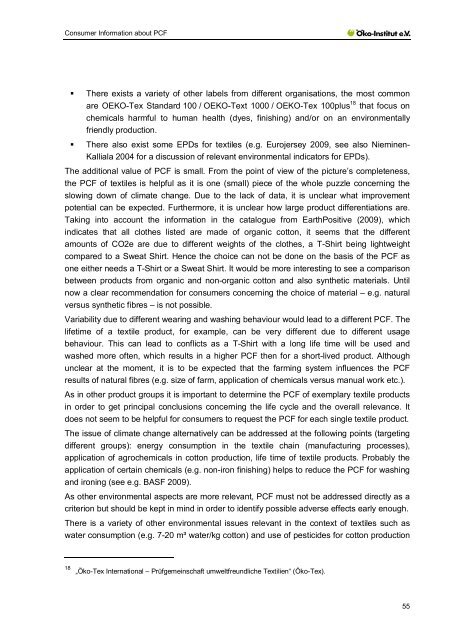Requirements on Consumer Information about Product ... - ANEC
Requirements on Consumer Information about Product ... - ANEC
Requirements on Consumer Information about Product ... - ANEC
Create successful ePaper yourself
Turn your PDF publications into a flip-book with our unique Google optimized e-Paper software.
C<strong>on</strong>sumer Informati<strong>on</strong> <strong>about</strong> PCF<br />
• There exists a variety of other labels from different organisati<strong>on</strong>s, the most comm<strong>on</strong><br />
are OEKO-Tex Standard 100 / OEKO-Text 1000 / OEKO-Tex 100plus 18 that focus <strong>on</strong><br />
chemicals harmful to human health (dyes, finishing) and/or <strong>on</strong> an envir<strong>on</strong>mentally<br />
friendly producti<strong>on</strong>.<br />
• There also exist some EPDs for textiles (e.g. Eurojersey 2009, see also Nieminen-<br />
Kalliala 2004 for a discussi<strong>on</strong> of relevant envir<strong>on</strong>mental indicators for EPDs).<br />
The additi<strong>on</strong>al value of PCF is small. From the point of view of the picture’s completeness,<br />
the PCF of textiles is helpful as it is <strong>on</strong>e (small) piece of the whole puzzle c<strong>on</strong>cerning the<br />
slowing down of climate change. Due to the lack of data, it is unclear what improvement<br />
potential can be expected. Furthermore, it is unclear how large product differentiati<strong>on</strong>s are.<br />
Taking into account the informati<strong>on</strong> in the catalogue from EarthPositive (2009), which<br />
indicates that all clothes listed are made of organic cott<strong>on</strong>, it seems that the different<br />
amounts of CO2e are due to different weights of the clothes, a T-Shirt being lightweight<br />
compared to a Sweat Shirt. Hence the choice can not be d<strong>on</strong>e <strong>on</strong> the basis of the PCF as<br />
<strong>on</strong>e either needs a T-Shirt or a Sweat Shirt. It would be more interesting to see a comparis<strong>on</strong><br />
between products from organic and n<strong>on</strong>-organic cott<strong>on</strong> and also synthetic materials. Until<br />
now a clear recommendati<strong>on</strong> for c<strong>on</strong>sumers c<strong>on</strong>cerning the choice of material – e.g. natural<br />
versus synthetic fibres – is not possible.<br />
Variability due to different wearing and washing behaviour would lead to a different PCF. The<br />
lifetime of a textile product, for example, can be very different due to different usage<br />
behaviour. This can lead to c<strong>on</strong>flicts as a T-Shirt with a l<strong>on</strong>g life time will be used and<br />
washed more often, which results in a higher PCF then for a short-lived product. Although<br />
unclear at the moment, it is to be expected that the farming system influences the PCF<br />
results of natural fibres (e.g. size of farm, applicati<strong>on</strong> of chemicals versus manual work etc.).<br />
As in other product groups it is important to determine the PCF of exemplary textile products<br />
in order to get principal c<strong>on</strong>clusi<strong>on</strong>s c<strong>on</strong>cerning the life cycle and the overall relevance. It<br />
does not seem to be helpful for c<strong>on</strong>sumers to request the PCF for each single textile product.<br />
The issue of climate change alternatively can be addressed at the following points (targeting<br />
different groups): energy c<strong>on</strong>sumpti<strong>on</strong> in the textile chain (manufacturing processes),<br />
applicati<strong>on</strong> of agrochemicals in cott<strong>on</strong> producti<strong>on</strong>, life time of textile products. Probably the<br />
applicati<strong>on</strong> of certain chemicals (e.g. n<strong>on</strong>-ir<strong>on</strong> finishing) helps to reduce the PCF for washing<br />
and ir<strong>on</strong>ing (see e.g. BASF 2009).<br />
As other envir<strong>on</strong>mental aspects are more relevant, PCF must not be addressed directly as a<br />
criteri<strong>on</strong> but should be kept in mind in order to identify possible adverse effects early enough.<br />
There is a variety of other envir<strong>on</strong>mental issues relevant in the c<strong>on</strong>text of textiles such as<br />
water c<strong>on</strong>sumpti<strong>on</strong> (e.g. 7-20 m³ water/kg cott<strong>on</strong>) and use of pesticides for cott<strong>on</strong> producti<strong>on</strong><br />
18 „Öko-Tex Internati<strong>on</strong>al – Prüfgemeinschaft umweltfreundliche Textilien“ (Öko-Tex).<br />
55
















